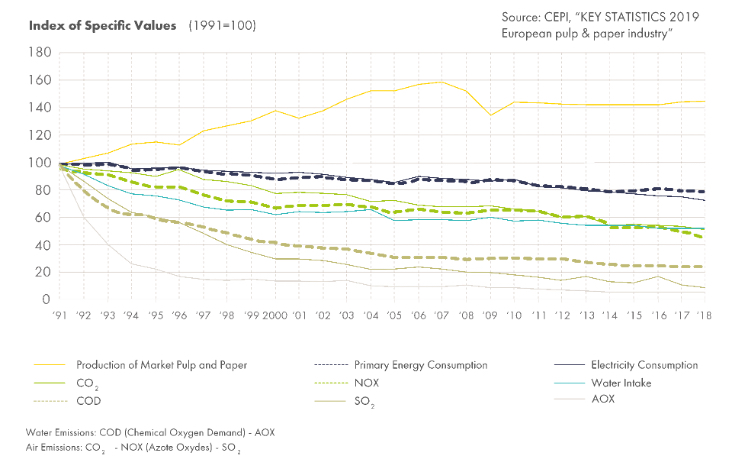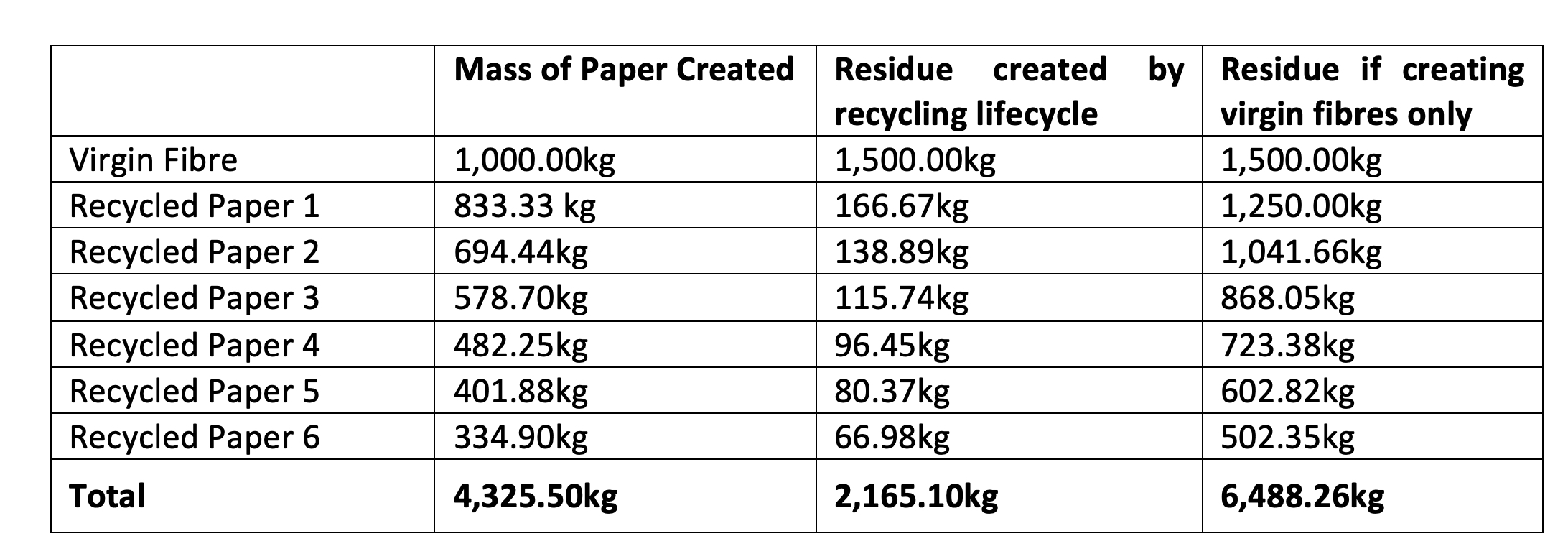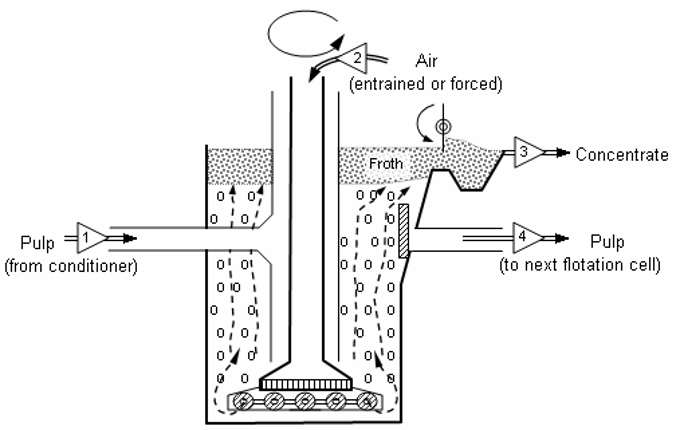Abstract
This essay explores the potential environmental savings that paper could make as part of the effort to tackle climate change. Paper is not included in the popular rhetoric of fighting climate change and is more often than not considered one of the causes.
Part of the perspective of this essay is to consider whether paper could in fact be a “Dark Horse” in the fight against climate change.
This essay will cover some statistical analysis, arguments from various sources and some potential future developments.
Part of the inspiration behind this essay is Jonathon Porritt’s “The World We Made” which covers a fictional character’s perspective from 2050 explaining how we saved the world by implementing various sustainable developments.
Hopefully this essay can investigate a less exposed proposition on combating climate change.
“It may sound frightening, but the scientific evidence is that if we have not taken dramatic action within the next decade, we could face irreversible damage to the natural world and the collapse of our societies. We’re running out of time, but there is still hope.”

Could Paper Be Key In The Fight Against Climate Change?
Climate Change
Climate change is a man-made, developing catastrophe that is threatening our way of life, or based on some projections endangers our existence. Climate change, also referred to as global warming is the increase in average temperature of the planet. This increase has been seen observed since the early 1800s following the Industrial Revolution and related pollutants.
According to NASA (2020), climate change manifests itself in different ways in different parts of the world. Increased heat, drought, and insect outbreaks all linked to climate change has led to knock-on-effects for people, animals and plants.
One of the key observations made by environmental scientists is that climate change is a self-perpetuating problem. This is due to the greenhouse effect in which gasses including carbon dioxide and methane are released into the atmosphere, trapping solar radiation heat from the Sun. The increase in temperature melts ice caps, releasing further methane into the atmosphere, potentially spiralling out of control:
“Melting Arctic sea ice is no longer just evidence of a rapidly warming planet – it’s also part of the problem.”
As such, it is no longer a case of making small changes; we need a paradigm shift to combat climate change and proactively reduce the amount of greenhouse gas emissions.
Paper
Paper is often vilified – the industry is deemed by many as a heavy destructor of rainforests and woodlands. Transactional companies have at times promoted “going greener by going paperless”. However, paper, particularly in Europe has become increasingly regulated, with the formation of the Forest Stewardship Council (FSC) in 1993 and Programme for the Endorsement of Forest Certification (PEFC) in 1999. These NGOs govern a chain of custody that means products with these accreditations have been manufactured from sustainably grown trees.
The modern paper industry, especially in Europe, is very sustainable. Latest figures show that European Forests have been growing by 1,500 football pitches every day. TwoSides (2020) say “between 2005 and 2020, European forests grew by 58,390 square kilometres – that’s an area bigger than Switzerland”.
Forest growth has a fantastic effect in producing oxygen and absorbing carbon dioxide. Forests have numerous other positive catalysts slowing down climate change not covered in this essay. There are also other less substantiated theories such as “Carbon locking” which hypothesises that carbon is more permanently locked into soil and plant-based products, having a long term benefit to taking carbon out of the air (Hiilipuu, 2020).
The manufacturing process for virgin fibre paper is energy intensive. The process of stripping the cellulose fibre from wood involves vast quantities of heat and steam – this cannot be avoided, but paper manufacturers have conceived innovative solutions to reduce the environmental impacts of these processes such as:
- Steam capture – reusing steam or capturing for energy generation.
- Water treatment – reusing water several times in manufacturing then removing contaminants, returning water to rivers cleaner than when extracted (Recycled Papers, 2018).
- Utilisation of by-products – Sappi (2019) are developing methods of using sugar by-products from their manufacturing process.
- Biomass – utilising by-products in a biomass boiler to generate energy.

Refinements in the paper making processes has led to increasingly sustainable practices. CEPI, the European association representing the paper industry have shown that despite an increase in the production of paper since 1990 (see Figure 1); the environmental impact has in fact decreased.
Even more alluring; paper can be recycled up to 6 times (Jonson and Nyberg, 2000) allowing further environmental savings to be made throughout its lifecycle.
Landfill vs. Incinerated vs. Recycled
When paper has been used for its intended purpose, waste-paper is created. This commodity can be dealt with in three key ways; landfill, incineration or recycling. Landfill and incineration both produce greenhouse gases. Paper in landfill will predominantly produce methane as it decomposes whereas incinerating paper creates carbon dioxide. Recycled Papers (2018) report that there is a significant downside to these methods of dealing waste papers:
- Burying waste paper as landfill releases methane gas, which is 23 times higher and more harmful to the environment than CO2.
- On average, the production of virgin fibre paper, followed by incineration uses twice as much energy than it takes to produce recycled paper.
- Recycling reduces CO2 emissions by 20% in comparison with incinerating the paper.
Making paper from recycled paper, as opposed to wood saves significant amounts of water and energy. In a simple experiment, it is clear that paper breaks down much more easily in water than wood. Wood takes much more energy to separate the cellulose fibres.
- The process of creating recycled paper uses 31% less energy than the creation of virgin fibre paper.
- Producing a tonne of recycled paper takes 35,000 fewer litres of water than producing one tonne of virgin fibre paper.
(Recycled Papers, 2018)
In Europe, the infrastructure for recycling paper is well established. According to the European Paper Recycling Council (EPRC), in 2019 the European paper recycling rate reached 72% making it one of the highest rates of recycling of any material.
Industry standards average that around 1.2 tonnes of recycled fibres are needed to produce 1 tonne of recycled paper and 2.5 tonnes of wood to make 1 tonne of virgin fibre paper. Far less residue is created in the manufacture of recycled papers. This logic has been extrapolated below to calculate the mass of paper created in the lifecycle of recycled paper vs. creating the same amount of virgin fibre paper.

Of course, these calculations are based on industry standards that follow a linear calculation, but throughout the lifecycle, the saving in residues is 66.63%.

The recycled paper de-inking process has been refined for decades (Amand, 1999). The process now uses a soap solution with bubbles pumped through. Ink particles attach themselves to the air bubbles and rise to the surface. This results in a surface froth of contaminants, fillers, ink and paper fibres that are too short for paper making and surface residue is siphoned off. The remaining cleaned fibres are treated with environmentally friendly bleaches such as hydrogen peroxide, which breaks down into water and oxygen.
The surface residue that is removed creates a useful by-product:
“90% of the residue produced by this process is put to agricultural use (composting and spreading), or used as a raw material to produce cement and bricks.”
It is becoming internationally recognised that recycled paper can offer a virtuous lifecycle whilst matching the quality of virgin fibre paper, with a lower environmental impact. This was recognised by world leaders when the COP21 agreement was signed on recycled paper in 2015.
Paper alternatives to other mediums
As a truly sustainable product, paper should be used to replace other mediums. Many paper and packaging manufacturers are driving innovations, replacing less renewable or non-renewable resources with paper-based alternatives.

Coca Cola are in the process of prototyping a paper bottle that could drastically reduce the amount of plastic that they produce every year. Other companies are increasingly replacing plastics in their products and manufacturing process that mean less unrecyclable waste is being produced each year.
It is also becoming increasingly clear that electronics and the electronic storage of information needs to be further investigated.
The ICT industry accounts for around 2.5-3% of global greenhouse gas emissions and this is predicted to rise to 14% by 2040
Replacing the electronic storage of information, involving energy intensive data warehouses, with some paper storage, could in some cases be worthwhile; locking in more carbon and with less energy intensive climates. Not only would that help in terms of energy usage – it could also help reduce unrecyclable e-waste which is a developing problem:
The electronic waste problem is colossal, and it’s growing. In 2016 alone, 44.7 million tonnes of e-waste were generated globally, of which 435 thousand tonnes were mobile phones, representing more than the mass of the Empire State Building.
Conclusion
Radical and immediate changes are needed to counteract climate change. Industries need to reform their operations to significantly turn the tide.
Change is needed in the public perception of paper and a need to further embrace the full lifecycle, including recycling waste-paper as many times as possible. We should avoid sending paper to landfill or incineration where possible. Maximising the utilisation of by-products, encouraging paper companies to further their research will also be a key factor in the development of the industry.
Paper shows some promising signs of having the capability of replacing less environmentally friendly materials such as plastics. Companies such as Coca Cola investing in this is a promising sign. Further exploration is needed into cutting the environmental impact.
Could paper be key in the fight against climate change? This essay has explored some very encouraging signs that paper can certainly play a part of a sustainable economy with many climate saving benefits. It will be extremely important that public demand for sustainable practices stays at the forefront as this will drive commercial decisions.
Specific Sources:
NASA (2020). The Effects of Climate Change. [online] last updated: November 21, 2020
Available at: https://climate.nasa.gov/effects/ [Accessed 23rd November 2020]
ScienceDaily (2013). Loss of Arctic sea ice speeds domino effect of warming temperatures at high latitudes. [online]. January 23, 2013.
Available at: https://www.sciencedaily.com/releases/2013/01/130123144044.html [Accessed 23rd November 2020]
TwoSides (2020). European forests have been growing by 1,500 football pitches every day! [online] FAO data 2005 to 2020.
Available at: https://www.twosides.info/european-forests/ [Accessed November 27, 2020]
Hiilipuu (2020). Carbon Cycle [online]
Available at: http://www.hiilipuu.fi/articles/carbon-cycle [Accessed November 27, 2020]
Sappi (2019). Sappi Group Sustainability Report. [printed and online] Published 2019.
Available at: https://cdn-s3.sappi.com/s3fs-public/2019-Sappi-Group-Sustainability-Report_v5.pdf [Accessed November 27, 2020]
Recycled Papers [maintained by Arjowiggins] (2018). Green Matters [online].
Available at: https://recycled-papers.co.uk/green-matters/ [Accessed December 3rd, 2020]
CEPI (2019). Key Statistics – European Pulp and Paper Industry [online].
Available at: https://www.cepi.org/key-statistics-2019/ [Accessed December 3rd, 2020]
Jönson, Gunilla and Nyberg, Lars (2000). How many times can the forest fibre be recycled? [printed and online]. Published 2000 by Lund University.
Available at: https://lup.lub.lu.se/search/publication/541324 [December 3rd, 2020]
European Paper Recycling Council (EPRC) (2019). The platform of the paper recycling chain. [online]
Available at: https://www.paperforrecycling.eu/ [Accessed December 3rd, 2020]
Amand, François Julien Saint (1999) Hydrodynamics of deinking flotation [printed and online]. Published 1999 by ELSEVIER and Centre Technique du Papier Domaine Universitaire.
Available at: https://www.sciencedirect.com/science/article/abs/pii/S0301751698000507 [Accessed December 3rd, 2020]
EnAcademic (2020) Flotation Deinking Image sourced form enacademic.com [online]
Available at: https://enacademic.com/dic.nsf/enwiki/11628601
Image link: https://enacademic.com/pictures/enwiki/70/FlCell.PNG
[Accessed December 3rd, 2020]
Packaging Europe (2020) Coca Cola Reveals First Paper Bottle Prototype [online]
Available at: https://packagingeurope.com/coca-cola-reveals-first-paper-bottle-prototype/ [Accessed December 5th, 2020]
TwoSides (2020). Ellen MacArthur Foundation (2018). Electronic Communication [online]
Available at: https://www.twosides.info/electronic-communication [Accessed December 6th, 2020]
General Sources:
Nature Research (2020) Climate tipping points — too risky to bet against [online]
Available at: https://www.nature.com/articles/d41586-019-03595-0 [Accessed November 23rd, 2020]
FSC (2020) Roadmap to Change [online]
Available at: https://fsc.org/en/impact/roadmap-to-change [Accessed November 23rd, 2020]
Attenborough/PBS (2020). David Attenborough on How Our Changing Climate Affects Wildlife. [online]. April 15, 2020.
Available at: https://www.pbs.org/wnet/nature/blog/david-attenborough-on-how-our-changing-climate-affects-wildlife/ [Accessed November 10th, 2020]
Triplepundit (2013). Deforestation and the Role of Paper Products [online]
Available at: https://www.triplepundit.com/story/2013/deforestation-and-role-paper-products/59071 [Accessed November 23rd, 2020]



